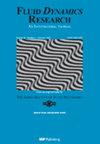纯模A和纯模B在圆柱尾流中的沿展向相变。第二部分:涡度的时空演化
IF 1.3
4区 工程技术
Q3 MECHANICS
引用次数: 0
摘要
摘要通过直接数值模拟,研究了在不考虑涡位错的情况下圆柱近尾迹从纯A型到纯B型的转变。雷诺数Re从100到330计算,计算的跨长为4个直径。在本节中,分析了涡度的时空演变及其标志。结果表明,当Re超过193时,B型涡实际上部分出现在柱体后表面和剪切层中,是一种具有相反符号的弱扰动涡量。随着Re的增加,近尾流旋涡脱落模式经历了B模式与完全发展的纯模式A耦合的初始产生阶段(193≦Re<230)、A模式与B模式之间的模式交换或共存阶段(230≦Re<260~265≦Re<310)、主导模式B的无量程展向波长从0.8到1的自我调整阶段(260~265≦Re<310)和模式B的完全发展阶段(Re≧310)。特别是,展向相变最初发生在初始生成阶段的某个展向位置,出现了一部分a型和一部分B型具有特定涡量符号的涡量,如a型为Π-涡量,B型为Π+涡量,其中Π-涡量和Π+涡量分别为满足涡量符号规律的三个涡量分量的涡量,分别从上层和下层剪切层脱落。本文章由计算机程序翻译,如有差异,请以英文原文为准。
Spanwise phase transition between pure modes A and B in a circular cylinder's wake. Part II: Spatiotemporal evolution of vorticity
Abstract Through direct numerical simulation, the transition from pure mode A to mode B in the near wake of a circular cylinder is studied without consideration of vortex dislocations. The Reynolds number Re is calculated from 100 to 330 with a computational spanwise length of 4 diameters. In the present section, the spatiotemporal evolution of the vorticity and its sign are analyzed. The results show that mode B, as a kind of weak disturbed vorticity with opposite signs, actually appears partially on the rear surface of the cylinder and in the shear layers once Re exceeds 193. With increasing Re, the vortex-shedding patterns in the near wake undergo the initial generation stage of mode B coupling with the fully developed pure mode A (193≦Re<230), the mode swapping or coexistence stage between modes A and B (230≦Re<260~265), the self-adjustment stage of the nondimensional spanwise wavelength from 0.8 to 1 in dominant mode B (260~265≦Re<310), and the full development stage of mode B (Re≧310). In particular, the spanwise phase transition initially occurs at a certain spanwise position in the initial generation stage where a part of mode A and a part of mode B with specific vorticity signs appear, e.g., the Π- vortex in mode A and the Π+ vortex in mode B, in which Π- and Π+ vortices are vortices with three vorticity components satisfying the vorticity sign law and shed from the upper and lower shear layers, respectively.
求助全文
通过发布文献求助,成功后即可免费获取论文全文。
去求助
来源期刊

Fluid Dynamics Research
物理-力学
CiteScore
2.90
自引率
6.70%
发文量
37
审稿时长
5 months
期刊介绍:
Fluid Dynamics Research publishes original and creative works in all fields of fluid dynamics. The scope includes theoretical, numerical and experimental studies that contribute to the fundamental understanding and/or application of fluid phenomena.
 求助内容:
求助内容: 应助结果提醒方式:
应助结果提醒方式:


